Swiftech H2O-120 Compact and Corsair Nautilus 500: Is Water Better?
by Wesley Fink on September 17, 2007 6:00 AM EST- Posted in
- Cases/Cooling/PSUs
Swiftech H2O-120 Compact
Swiftech specializes in cooling for the enthusiast market. It is probably best known for its liquid cooling solutions, but Swiftech began with air cooling and has also had a few air coolers that were very well-known, like their ongoing MC and MCX air coolers for AMD and Intel. Swiftech also markets thermoelectric cooling parts, specialty ram and MOSFET coolers, and even a specially modified Antec P180 case called the QPower P180 for water cooling.
The Company was founded in 1994 by Gabriel Rouchon, incorporated in 2001, and was first publicly traded in 2005. Though there have been many changes in the company's structure over the years, it is worth mentioning that Gabe Rouchon is still very active in Swiftech, and Gabe often works directly with reviewers on tweaking the company's cooling products.
Swiftech markets both individual cooling products such as CPU water blocks, chipset and VGA water blocks, pumps, radiators, reservoirs, and cooling accessories. They also market complete water cooling kits such as the H2O-220 Apex Ultra and the H2O-80 Micro. Their newest kit, the H2O-120 Compact is the subject of this review.

The complete H2O-120 Compact kit comes packaged in a small box measuring roughly 13x7x4 inches. Everything needed for a standard Intel or AMD installation is included in the package.

The radiator/reservoir and water block/pump are well protected by the cutouts in the rigid foam block. Components are located on both the top and bottom of the Styrofoam. If you can't find the funnel it's mounted on the bottom.

You can see how much Swiftech has simplified this water cooling system by looking at the small number of parts compared to traditional water cooling kits. The fan/radiator/reservoir is basically one module, and the water block/pump is the second module. These two components are connected by pre-cut 10" Neoprene 3/8" tubes. All of the hardware for mounting is included, such as the mounting screws, Intel backplate (shipped attached to the Apogee Drive Block), a 7V electrical connector for running the fan at low speed, Arctic Silver Ceramic thermal grease, and the water additive. An alternate mounting block is also included for AMD/AM2 processor mounting.
Swiftech does not include the distilled water required for filling the system. Specialty cooling etailers and scientific equipment shops carry this; however, the most readily available source for distilled water we found is Wal-Mart, where a gallon of distilled water was less than a buck. The coolant additive is mixed with a half liter (pint or 16 oz.) of distilled water.
Installation
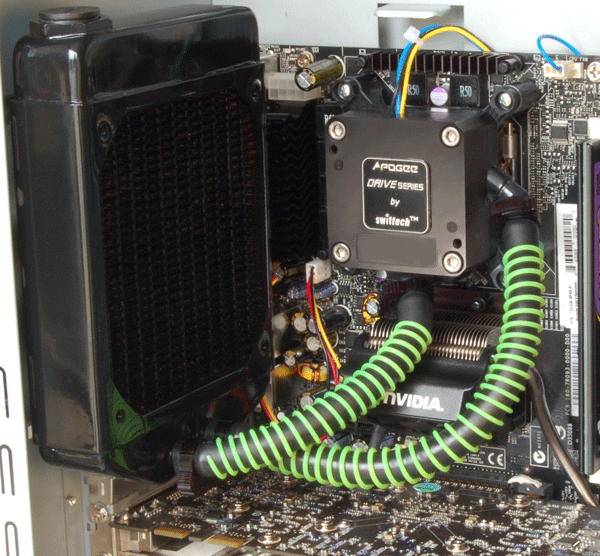
The kit mounts just fine in a full tower case, and it will mount fine in an Antec P180 which mounts the power supply at the bottom of the mid-tower case. The kit as supplied did fit any bottom-mount mid-tower case available for testing. However, the Swiftech H2O-120 Compact kit would not fit any top-mount power supply mid-tower case we tried. This included about six different brands of the most common top-mount PSU cases, either premium or value brands. The radiator is about a half inch too long to mount in top PSU mid-tower cases. Those equipped with 120mm exhaust fans all had screw holes that would not allow mounting of the radiator.
Both our old and new cooling test beds are top PSU mid-tower cases, and the H2O-120 Compact would not fit either case as supplied. We used that configuration because this is the case design readers most often own - it is the most common case available and accounts for the most sales. To be fair to other solutions, it was possible to find a way to install the H2O-120 Compact in the test bed case, so we could advise readers of what was needed to mount in this common design.
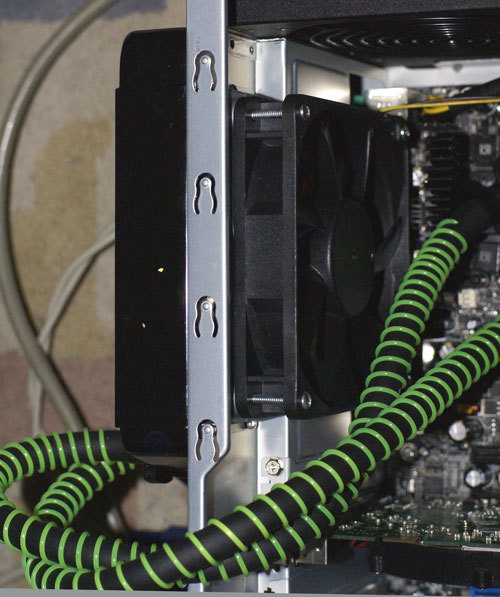
The easiest mount was a split design, where the radiator was mounted outside the case and the fan is inside the case. To use this mount you will need longer screws in some mid-tower cases and a longer pair of hoses. We found the 12" length worked fine in our case, and extra hoses are available from Swiftech.
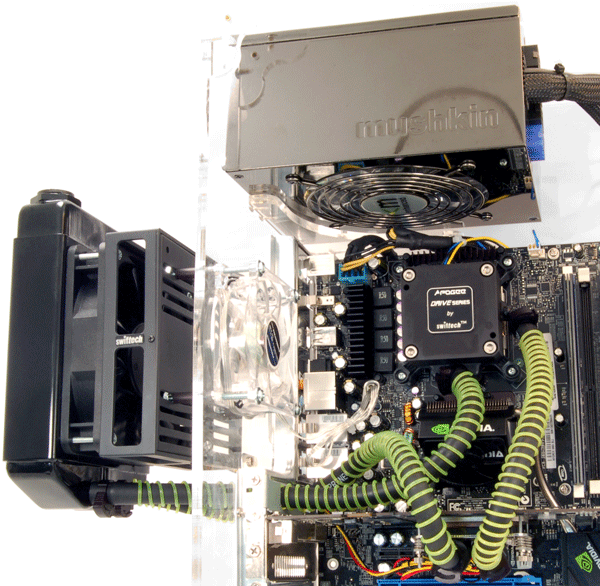
When there is not enough room for the radiator, Swiftech recommends using their "Radbox" for external mounting.
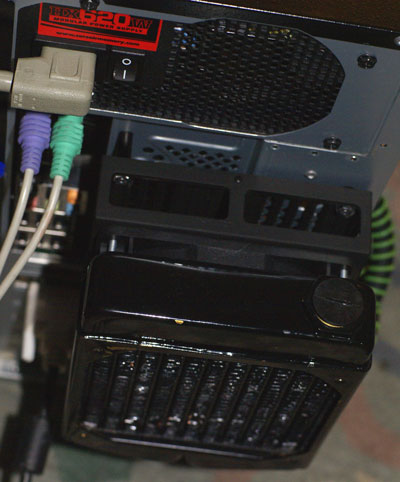
You will also need longer tubing for the Radbox install, but all the necessary screws and washers come with the Radbox from Swiftech. The Radbox kit even includes a PCI slot cover for running tubing to the outside of the case for external radiator mounting.
Performance tests were run with both the split-install configuration and the recommended Radbox external configuration. Cooling results were all but identical; the recommended external install was 0C to 2C cooler at most speeds. If your 120mm grill is not perforated enough you may have to remove the fan circle for best cooling, but the kit cooled fine on our test bed with the perforated 120mm grill intact.
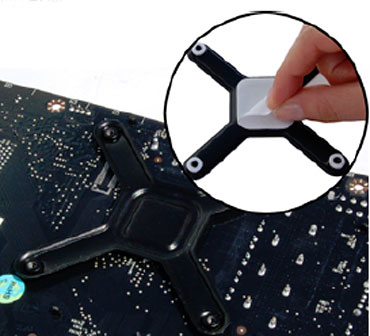
Once you have determined fit and decided on how you will mount the H2O-120 Compact you will need to assemble and leak test the water cooling system. The Intel 775 block requires a back plate so you will have to remove the motherboard to install the water cooling system. It was easiest for us to stick or tape the back plate to the motherboard and remount it for final install, because we strongly advise testing for leaks before mounting the system over the motherboard.

In a standard install everything is inside so you can attach the tubes, fill the system and operate the pump away from the computer. The manual includes information on how to run the power supply to test the system, before it is installed on the motherboard.
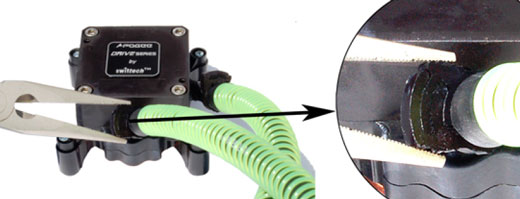
On the installs with the radiator outside the case you will have to plan assembly and water testing, since the water system should be filled after the tubes are passed through the PCI slot. The tubes for external mount were long enough that the Apogee block could dangle from inside the case to the outside for filling and leak testing. The apogee block was dangled over the back on a dry cloth for leak-testing where the tubing needed to pass though the PCI bracket.
The bottom line on installation is that the standard install is relatively simple, and it is definitely much simpler than the traditional four component water cooling systems. If you are a first-time water cooling installer and the system fits your case, 30 minutes is probably a reasonable time to install. However, if you are installing in a top PSU mid-tower case you will need to buy or order parts, carefully plan your install, and it will take an hour or more to install the system once your parts arrive. The penalty for a sloppy install without leak testing could be a dead motherboard and CPU, so we strongly recommend that you take your time and use the precautions necessary to assure you have a leak-proof water system.
Swiftech specializes in cooling for the enthusiast market. It is probably best known for its liquid cooling solutions, but Swiftech began with air cooling and has also had a few air coolers that were very well-known, like their ongoing MC and MCX air coolers for AMD and Intel. Swiftech also markets thermoelectric cooling parts, specialty ram and MOSFET coolers, and even a specially modified Antec P180 case called the QPower P180 for water cooling.
The Company was founded in 1994 by Gabriel Rouchon, incorporated in 2001, and was first publicly traded in 2005. Though there have been many changes in the company's structure over the years, it is worth mentioning that Gabe Rouchon is still very active in Swiftech, and Gabe often works directly with reviewers on tweaking the company's cooling products.
Swiftech markets both individual cooling products such as CPU water blocks, chipset and VGA water blocks, pumps, radiators, reservoirs, and cooling accessories. They also market complete water cooling kits such as the H2O-220 Apex Ultra and the H2O-80 Micro. Their newest kit, the H2O-120 Compact is the subject of this review.

The complete H2O-120 Compact kit comes packaged in a small box measuring roughly 13x7x4 inches. Everything needed for a standard Intel or AMD installation is included in the package.

The radiator/reservoir and water block/pump are well protected by the cutouts in the rigid foam block. Components are located on both the top and bottom of the Styrofoam. If you can't find the funnel it's mounted on the bottom.

You can see how much Swiftech has simplified this water cooling system by looking at the small number of parts compared to traditional water cooling kits. The fan/radiator/reservoir is basically one module, and the water block/pump is the second module. These two components are connected by pre-cut 10" Neoprene 3/8" tubes. All of the hardware for mounting is included, such as the mounting screws, Intel backplate (shipped attached to the Apogee Drive Block), a 7V electrical connector for running the fan at low speed, Arctic Silver Ceramic thermal grease, and the water additive. An alternate mounting block is also included for AMD/AM2 processor mounting.
Swiftech does not include the distilled water required for filling the system. Specialty cooling etailers and scientific equipment shops carry this; however, the most readily available source for distilled water we found is Wal-Mart, where a gallon of distilled water was less than a buck. The coolant additive is mixed with a half liter (pint or 16 oz.) of distilled water.
Installation

The kit mounts just fine in a full tower case, and it will mount fine in an Antec P180 which mounts the power supply at the bottom of the mid-tower case. The kit as supplied did fit any bottom-mount mid-tower case available for testing. However, the Swiftech H2O-120 Compact kit would not fit any top-mount power supply mid-tower case we tried. This included about six different brands of the most common top-mount PSU cases, either premium or value brands. The radiator is about a half inch too long to mount in top PSU mid-tower cases. Those equipped with 120mm exhaust fans all had screw holes that would not allow mounting of the radiator.
Both our old and new cooling test beds are top PSU mid-tower cases, and the H2O-120 Compact would not fit either case as supplied. We used that configuration because this is the case design readers most often own - it is the most common case available and accounts for the most sales. To be fair to other solutions, it was possible to find a way to install the H2O-120 Compact in the test bed case, so we could advise readers of what was needed to mount in this common design.

The easiest mount was a split design, where the radiator was mounted outside the case and the fan is inside the case. To use this mount you will need longer screws in some mid-tower cases and a longer pair of hoses. We found the 12" length worked fine in our case, and extra hoses are available from Swiftech.

When there is not enough room for the radiator, Swiftech recommends using their "Radbox" for external mounting.

You will also need longer tubing for the Radbox install, but all the necessary screws and washers come with the Radbox from Swiftech. The Radbox kit even includes a PCI slot cover for running tubing to the outside of the case for external radiator mounting.
Performance tests were run with both the split-install configuration and the recommended Radbox external configuration. Cooling results were all but identical; the recommended external install was 0C to 2C cooler at most speeds. If your 120mm grill is not perforated enough you may have to remove the fan circle for best cooling, but the kit cooled fine on our test bed with the perforated 120mm grill intact.

Once you have determined fit and decided on how you will mount the H2O-120 Compact you will need to assemble and leak test the water cooling system. The Intel 775 block requires a back plate so you will have to remove the motherboard to install the water cooling system. It was easiest for us to stick or tape the back plate to the motherboard and remount it for final install, because we strongly advise testing for leaks before mounting the system over the motherboard.

In a standard install everything is inside so you can attach the tubes, fill the system and operate the pump away from the computer. The manual includes information on how to run the power supply to test the system, before it is installed on the motherboard.

On the installs with the radiator outside the case you will have to plan assembly and water testing, since the water system should be filled after the tubes are passed through the PCI slot. The tubes for external mount were long enough that the Apogee block could dangle from inside the case to the outside for filling and leak testing. The apogee block was dangled over the back on a dry cloth for leak-testing where the tubing needed to pass though the PCI bracket.
The bottom line on installation is that the standard install is relatively simple, and it is definitely much simpler than the traditional four component water cooling systems. If you are a first-time water cooling installer and the system fits your case, 30 minutes is probably a reasonable time to install. However, if you are installing in a top PSU mid-tower case you will need to buy or order parts, carefully plan your install, and it will take an hour or more to install the system once your parts arrive. The penalty for a sloppy install without leak testing could be a dead motherboard and CPU, so we strongly recommend that you take your time and use the precautions necessary to assure you have a leak-proof water system.










58 Comments
View All Comments
geok1ng - Wednesday, July 23, 2008 - link
There is no reason to dump $120+ on a budget water cooling system for CPUs since most sub$50 air coolers will do a good jobbut with SLI/crossfire systems the typical air cooling solution are suboptimal to say the least. Even you have a board that can fit 2 VGA and 2 Acellero S1s, there is no way to put good airflow averthe humungous setup!
Someone plaese give us a water cooling solution for multi GPU systems that doesnt cost MORE than the VGAs!
Cregaune - Tuesday, March 25, 2008 - link
This review has given me lots of food for thought. Frankly, I find the conclusion incredible.Perhaps you guys are right, but before people jump to your conclusions I wonder why your ambient room temps were kept within such loose margins i.e 20'C to 22'C.........a full 3'C !!!
Controlling ambient room temperature is particularly important when reviewing a water cooled system, simply because it can take an hour or more for the coolant temperature to stabilise; before you can legitimately take a reading. If, in the meantime, you let the room temperature fluctuate within such grossly wide margins, your results are next to useless....especially given the relative performance figures in your findings.
Just a thought!
Cableaddict - Friday, April 11, 2008 - link
Wesley,As far as performance goes, I'd say you present a valid argument. The specific kits you tested are not worth investing, vs a few of the best air-coolers. So far, so good, but your conclusions and general tone seem to fail badly after that one true point.
You wrote, (in this thread) "We state you will likely need to spend more than $300 to possibly outperform current top air coolers."
Nonsense. As many have mentioned, the big problem with these kits is the use of a single "220" size radiator. Using a dual-rad, or two singles, has been shown in test after test to increase cooling dramatically (even with a "lowly" Swiftech rad) So, one could buy the H2O-120 and add another radiator for $42 more. That's WELL under $200, and the performance OC'ed & under load will slightly outperform the Ultra-120. AND , it will be much less noisy.
You conclusions about noise are correct, but only at lower fan speeds.You posted a chart showing high OC / high load performance, but failed to include noise specs under those conditions. The noise comparisons at lower cooling settings do not apply at all. I've been looking at TONS of tests, specifically weighing cooling vs noise. At the high speeds needed to make the Ultra-120 types perform their best (about equal to a low-end dual radiator WC) they are much, MUCH noisier than WC, according to every test I've read.
Last: Bear in mind that many folks cannot fit those big air-coolers, espially HTPC people, or those with rack-mount music & video pc's. For such rigs, the best air coolers that will actually fit are the Gemini II, the DuOrb, etc. Even a single-rad WC setup does better than those when OC'ed & under load. (according to many tests I've seen.) With a dual-rad, WC systems decimate these air-coolers. For instance, one test put a Gemini II / dual Noctua blower against the H2O-220 kit. At 3.7 Ghz, under load, the WC was 15º cooler.
-----------
Regarding pump noise: Well again, your comparisons are fair if one is going to strictly obey the "rules" and not mod any system at all. However, One can pretty easily add sonex or other noise absorbtion to the inside of the case, and limit a good bit of that pump noise.
Going to a non-kit system, one can now choose the Lang D5 vario, dial it down a little, and add some sound isolation around it. Not so hard, and all reports say it is then virtually silent. With a dual-rad performance should still be excellent. Granted, that's approaching the $300 mark, but serious overclockers would certainly do better with such a set-up, and it would be LESS noisy.
I guess one last question must be addressed, and that is: Just how cool do we need to go? Let's say one want to OC a Q6600 (timeframe of this review) to 3.8 ghz. A $75 air-cooled rig will run under heavy load at (let's say) 60º, and a decent WC rig will run it at 50º. Is 60º safe enough, day after day, that the WC system is not worth the substantial cost? I don't know the answer. I wish I did.
-And when pushing the FSB really hard, one might worry about the rest of the mobo components. -So now we have to weight the WC advantage of being able to also cool the NB and GPU, vs the air-cooler advantage of cooling the ram,NB, mosfets, etc.
One might reasonably say that,with heavy OC, a WC set-up requires an additional case fan, and that means a little more noise.
Complicated...
Cableaddict - Friday, April 11, 2008 - link
Custom H2O-220 type system:Swiftech Apogee Drive 350 Pump / CPU water block combo $80
Swiftech MCR220-res: $55
2 Noctua fans: $50
non-evaporate hoses / clamps: ~ $20 MAX.
Hydrex: $3
------------------------------------------
$210 or less.
Swap-in a Lang Vario D5 pump and an Apogee or Fuzion waterblock, instead of the Apogee Drive 350, and you still under $275.
Test either of these systems on a Q6600 @ 3.8 Ghz, against any air system, includng the Ultra-120, and then get back to me.
Also bear in mind that either of these systems will easily also cool a GPU, with another $50 of parts.
Cableaddict - Saturday, April 26, 2008 - link
One more noise consideration:Granted this is a review of the H2O single, but for very little more money one can get the H2O with a double rad. THAT system should slightly outcool even the ultra-120, but what;s most important is that it will be MUCH quieter.
Again, the Ultra-120 types require pretty high CFM's to give good results. A dual radiator can deliver excellent performance with a pair of Nocyua 1300 rpm fans. That's bloody silent.
perfectdarth - Sunday, December 30, 2007 - link
you cant say say that watercooling is bad because a 2 budget kits get beaten by an ultra 120. watercooling does cost more but radiators and pumps last years and for $300 (no more) you could make a custom kit that would be quite a bit better than the top air coolers when cooling an overclocked cpu.you harped on how watercooling costs more and takes more time/effort but you didnt state that people that are willing to spend the extra time/money dont always do it just for better temperatures and might find it fun and a bit of a challenge the first time. putting on a heatsink isnt very satisfying, you could train a monkey to do that. you could say people who spend $800 on a graphics card to play games at max are stupid because its still the same game at medium on a $350 graphics card but if you like to lay games that look nice you would think its worth it, it was like you had your mind made up before you wrote this article
people saying that the hassle of watercooling isnt worth it is just plain ignorance, some people enjoy maintaning their car themselves but other people would go meh and go pay someone to check their oil and water. that doesnt mean that people who dont care should tell the people that do it themselves that they are wasting time or the they should tell the lazy ones they shouldnt be lazy. watercooling is a hobby just as much as it is a way to better cool your computer.
i would like to see the swiftech h20-220 Apex Ultra tested against the top aircoolers since it is a very good kit and under $300 afaik. also watercooling seems to make a much bigger difference to graphics cards than cpus.
saying that you would rather buy a phase change over a good watercooling kit is rediculous. phase is more work and just as if not more risky than watercooling because of condensation.
also why farcry and not use tat or orthos? i didnt like this article much since it is very bias towards air. i read "water is useless air is so much better" all the way through.
rabident - Tuesday, September 25, 2007 - link
You could argue heatpipe coolers are closer to water coolers than air coolers. They're basically sealed water coolers. Most use distilled water as the heat transfer medium, just like conventional after coolers, except heat pipes are more efficient because they involve a phase change (which absorbs a lot of heat).The real value with conventional watercooling is the freedom to piece together a custom cooling system that meets your needs. It lets you balance price, cooling performance, and noise the way you see fit. Plus there's a lot of room for creativity.
I think it's going be hard for water to beat air in price/performance, but if price is the #1 factor then I think the value of any after market coolers is questionable.
Starglider - Sunday, September 23, 2007 - link
This review is ok, nothing amazing but the accusations being thrown around seem unwarranted. However the basic conclusion is this; modern heatsinks are good enough that for a single medium-speed 120mm fan, cooling is airflow and radiator surface limited. With heatpipes and improved layout heatsink thermal conductivity is no longer an issue (for quality air coolers).It would be nice if this was made more explict in the conclusions, and I am dubious about the claim that you can't get a better radiator solution (e.g. dual-120mm or reserator) for under $200. The notion that water cooling won't give you any advantage other than chipset/GPU cooling is false in the general case; it is only true if you have a single 120mm fan radiator (plus it ignores the benefit of lowing case internal temps).
strikeback03 - Wednesday, September 19, 2007 - link
So is the "water additive" really just old-school green automotive coolant, i.e. ethylene glycol? Or does it just look that way?aigomorla - Tuesday, September 18, 2007 - link
http://www.vr-zone.com/articles/Swiftech_H20-120_C...">http://www.vr-zone.com/articles/Swiftec..._Compact...Sorry. This review was better writen. And shows this cooler clearly owning air.
The editor i feel now has a grudge against water cooling. He is pushing air is greater then water when it looks like he has no experience with a decient water setup.
The pump making a lot of noise? Okey, can one owner who has a DDC confirm this? Because i have 4 and none of them make loud noises.
The Liang D5 doesnt even make loud noise, and its a bigger pump.
Sorry your 300+ watercooling comment needed to beat air... thats absolute BS.
People please do some research b4 you buy into this review. I asked the editor polietly to remove that statement and he has yet to remove it. I ask you guys to check out our case and cooling forum. There is a post on this and listen to what all the members on AT are saying. Only the editot of this article believes in his 300+ needed to beat air. The rest of the members on board totally disagree with him. XS is laughing at anandtech at the moment. Even the air cooling people at XS are laughing because its a KNOWN FACT a 120x2 radiator would demolish anything AIR can bring up. Even TEC air coolers dont stand a chance.